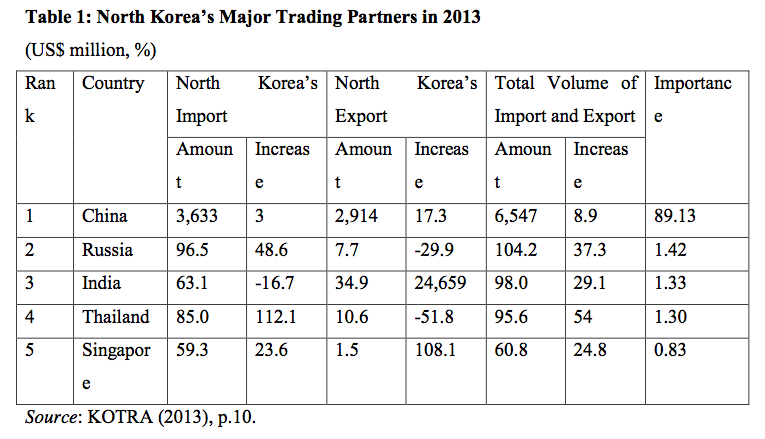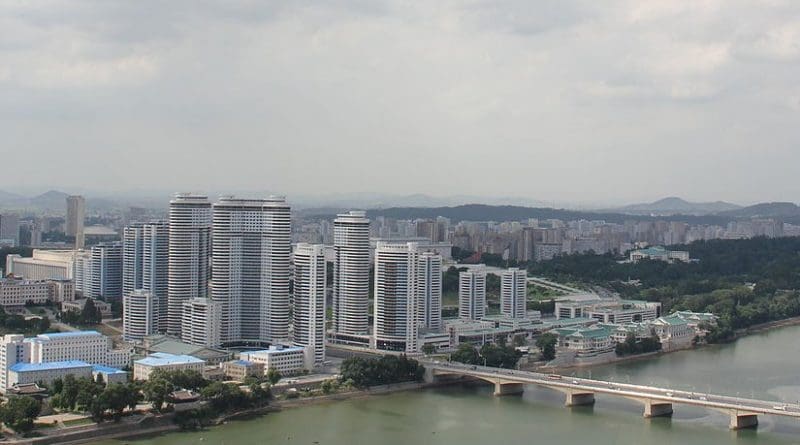Political Risks In India-North Korea Ties – Analysis
By Institute of South Asian Studies
North Korea’s latest expression of interest in humanitarian help from India has brought into new focus the whole issue of economic engagement between the two countries. India may well have to weigh the political risks at stake, given Pyongyang’s close strategic links with both China and Pakistan.
By Sojin Shin*
How has the political and economic relationship between India and Democratic People’s Republic of Korea (North Korea hereafter) evolved? The Government of India defines that India-North Korea relations have been “generally characterised by friendship, cooperation, and understanding”.2
Such friendship, cooperation, and understanding are probably the norms that dictated the positive response by India’s External Affairs Minister Sushma Swaraj to a request from Ri Su Yong, North Korea’s Foreign Minister, to visit India for humanitarian assistance.3 The visit took place in May 2015. This came as a surprise, though. North Korea might have already stepped on India’s toes because of Pyongyang’s long suspected nexus with Pakistan in its nuclear-weapons and ballistic-missile programmes that had threatened India’s security.
At the same time, North Korea’s recent approach to India is strategic, since its ties with China have become flexible. This paper briefly discusses the evolution of India-North Korea relations.
The Underdeveloped Communist Connection
The political links between India and North Korea can be traced to the 1950s, 1960s, and 1970s when both countries were strongly influenced by socialist orientation. Since the 1960s, delegations between the two countries have usually included communist party functionaries and trade union leaders.4 Further, Indian newspapers were once used by the North Korean Consulate in India to carry propaganda for Kim Il-Sung in the 1970s.5 As such, the governments in both countries maintained a political connection that did not harm each other’s interests during the period, even though India pursued non-alignment on the international stage.
However, the India-North Korea political ties could not blossom much because China was always concerned about those dynamics. Especially, the North Korea-China friendship was very close in the 1960s and the 1970s. Even though India-North Korea relationship was not bad in the same period, Pyongyang supported China rather than India when India and China had an issue over their conflicting national interests. For example, North Korea pursued anti- India propaganda during the Sino-Indian War in 1962. The Government of India noted in 1963 that North Korea “falsely accused India of committing aggression on Chinese territory and of spurning Chinese efforts to solve the border question through negotiations”.6
As China opened its economy and society to the outside world for the purpose of economic growth in the past several decades, the so-called “lips and teeth” relationship between China and North Korea began to change substantially. Beijing seems to have realised that its close relationship with North Korea might hinder China’s further growth in many ways, even as China’s relations with the international community, and the US in particular, began warming up.7 The slogan of “lips and teeth” relationship now looks very obsolete indeed. This change may have compelled Pyongyang to approach India as a humanitarian partner that could help North Korea with economic aid programmes.
Another reason why the India-North Korea relationship could not develop much was Pyongyang’s close relations with Pakistan over its nuclear-weapons programme. The nuclear projects have drawn heavy criticism from neighbouring countries such as India, South Korea, and Japan and the international community including the US. Both North Korea and Pakistan are known to assist each other in the fields of liquid-fuel long-range ballistic missiles, missile technology, and components. This nuclear-and-missile nexus between the two countries seemed to have been enhanced in the 1990s when Pakistan provided North Korea with weapons-grade uranium while North Korea supplied Pakistan with missiles in turn.8
The Government of India has revealed its concern about the North Korea-Pakistan nuclear nexus. Jaswant Singh, who served as the Minister of External Affairs in the National Democratic Alliance (NDA) Government under Vajpayee’s leadership, had said, “The reports [about the North Korea-Pakistan nexus] are not new to us; they confirm the validity of government’s own assessment. Government has conveyed to its interlocutors our concern about the adverse effects on India’s security from continuing nuclear and missile proliferation in Pakistan, despite the existence of various export control regimes and declarations of restraint by supplier countries”.9 The Japanese Government also mentioned, “As for the reports that Pakistan cooperated with North Korea on the North’s nuclear weapons programme, we are naturally concerned with a (relevant) report related to North Korea’s nuclear weapon programme. We will continue to observe this issue closely”.10
Poor Outlook in India-North Korea Trade and Investment
In June 2014, North Korea integrated three different state agencies that promote foreign trade, foreign investments, and special economic zones into the Ministry of External Economic Affairs. It aims at extending its trade relations to Russia, Japan, and many other countries in the Middle East and Africa. India is also in the picture.
According to the Korea Trade-Investment Promotion Agency (KOTRA) under the Ministry of Trade, Industry and Energy in South Korea, India was third in North Korea’s trade volume in 2013.11 As can be seen in Table 1, India took up 1.3% of total trade volume of North Korea showing the dramatic growth of imports from North Korea. Despite the dramatic change, China has been far ahead of trade and investments into North Korea.

According to the Government of India, the total amount of trade between India and North Korea until 2014 was US$ 199 million.12 Various items have been exported from India to North Korea including ores, minerals, drugs, pharmaceuticals, machinery, and many others while the main items of import from North Korea are limited to iron and steel.
However, bilateral trade between India and North Korea recently declined mainly due to North Korea’s financial inability. A source of the Government of India said,
DPRK [North Korea] expressed keen interest in importing consumer goods from India every year on ‘deferred payment basis’. These items include leather shoes, stockings, undergarments, school bags, bicycles, kitchen utensils, etc. They also proposed barter trade by supplying items like steel, magnesia clinker zinc, etc. in case deffered payment option is not acceptable to India. They also welcomed participation of Indian companies, Chambers of Commerce, Business houses, etc. in their annual trade fairs and various other events for promoting Indian products in DPRK market. They also welcome participation of Indian companies in joint ventures and FDI.13
Recently, the Kim Jong Un regime in North Korea has aggressively begun attempts to attract foreign investments, through economic reforms, especially to the special economic zones. Pyongyang appeals to big companies from South Korea and Japan to build infrastructure projects in North Korea. However, the companies seem to be hardly convinced that their businesses would be successful, given the continuing political and economic uncertainty of North Korea.
Challenges and Suggestions
The political and economic regimes in India and North Korea have evolved in considerably different ways for the past 60 years, although the two countries were heavily influenced by socialist orientation in the 1950s. India is the biggest democratic country and one of the most powerful emerging market economies in the world, while North Korea is an isolated communist state in poverty. North Korea’s approach to India seems very strategic, as its relations with China have become estranged.
India’s Prime Minister Narendra Modi’s recent visit to China and South Korea was aimed at enhancing India’s economic relations with those countries. It must have been threatening to North Korea’s relations with its neighbouring countries, given its economic backwardness. If investors from India want to enter the North Korean market, they need to pay particular attention to the North Korea-Pakistan and North Korea-China relations. When the Indian companies feel secure not only about the political risks relating to North Korea’s ties with Pakistan and China but also about their capacity to compete with the Chinese companies in the North Korean market, investments to North Korea may have a chance of success.
About the author:
* 1 Dr Sojin Shin is Visiting Research Fellow at the Institute of South Asian Studies (ISAS), an autonomous research institute at the National University of Singapore. She can be contacted at [email protected]. The author, not ISAS, is responsible for the facts cited and opinions expressed in this paper.
Source:
This article was published by ISAS as ISAS Brief Number 382 (PDF)
Notes:
2. Government of India, the Ministry of External Affairs. “India-DPR Korea Relations.” Data is available at http://mea.gov.in/indian-mission.htm?504/Korea_DPR (accessed on 23 April 2015).
3. Ri Su Yong expressed appreciation for India’s food assistance worth US$1 million in 2011 and sought additional assistance from India. Due to the ongoing financial difficulties in North Korea, the scope of bilateral relations between the two countries has been widened to cover humanitarian assistance from India to North Korea.
4. See Government of India, various issues of Rajya Sabha Debates, for the list of two-way delegations from India and North Korea.
5.The newspapers include various national and regional branches of The Hindu, The Indian Express, The Daily Milap, Times of India and many others. See Government of India (1971), “Advertisements in Indian News Papers by North Korean Consulate.” Rajya Sabha Debates. Issued on 16 June. Accessed on 27 April 2015.
6.Government of India (1963), “Anti-India Propaganda by North Korean Journals.” Rajya Sabha Debates. Issued on 19 March. The Ministry of External Affairs: New Delhi. Accessed on 23 April 2015.
7.The problems between China and North Korea, for example, include the issue of North Korean refugees to China. See Anne Wu, “What China Whispers to North Korea.” The Washington Quarterly, 28(2): 35-48.
8. See Government of India (2002), “Pakistan’s help to North Korea”. Rajya Sabha Debates. Issued on 28 November. Ministry of External Affairs: New Delhi. Accessed on 27 April 2015.
9. Government of India (2001), “Suspected Nexus between Pakistan and North Korea”. Rajya Sabha Debates. Issued on 9 August. Ministry of External Affairs: New Delhi. Accessed on 27 April 2015.
10. Government of India (2003), “Japan’s Opposition on Transfer of Nuclear Technology to North Korea”.
Rajya Sabha Debates. Issued on 8 May. Ministry of External Affairs: New Delhi. Accessed on 27 April 2015.
11. KOTRA (2013), 2013 Nyun Bukhan Daeoeimuyeokdonghyang [The Trend of Foreign Economic Policy in North Korea 2013]. Accessed on 19 May 2015.
12. Government of India, the Ministry of Commerce and Industry. See the footnote 2.
Data is available at http://www.commerce.nic.in/eidb/iecnt.asp (accessed on 30 April 2015).
13. Government of India, op. cit. See the footnote 2.

